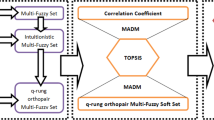Abstract
This paper proposes a new fuzzy ranking method named relative distance metric method, which can overcome some of the shortcomings for previous ranking methods and select the best alternative in selecting weapon systems. There are two objectives in this paper. Firstly, we propose a new ranking method and compare our method with other methods by many examples. The second objective is applying the proposed method to rank the best self-propelled Howitzers and main battle tanks.
Similar content being viewed by others
References
Bass SM, Kwakernaak H (1977) Rating and ranking of multiple aspect alternatives using fuzzy sets. Automatica 13:47–58
Chang J-R, Cheng C-H, Kuo C-Y (2006) Conceptual procedure for ranking fuzzy numbers based on adaptive 2-dimensions dominance. Soft Comput 10:94–103
Chang W (1981) Ranking of fuzzy utilities with triangular membership function. In: Proceedings of the international conference on policy analysis information system, pp 263–272
Chen CB, Klein CM (1997) A simple approach to ranking a group of aggregated fuzzy utilities. IEEE Trans Syst Man Cybern 27:26–35
Chen CB, Klein CM (1997) An efficient approach to solving fuzzy MADM problems. Fuzzy Sets Syst 88:51–67
Chen LS, Cheng CH (2005) Selecting IS personnel use fuzzy GSS based on metric distance method. Eur J Oper Res 160:803–820
Chen SH (1985) Ranking fuzzy numbers with maximizing set and minimizing set. Fuzzy Sets Syst 17:113–129
Chen SJ, Hwang CL (1992) Fuzzy multiple attribute decision making methods and applications. Lecture notes in economics and mathematical systems. Springer Berlin Heidelberg, New York
Chen SM (1996) Evaluating weapon systems using fuzzy arithmetic operations. Fuzzy Sets Syst 77:265–276
Cheng CH (1996) Evaluating naval tactical missile systems by fuzzy AHP based on the grade value of membership function. Eur J Oper Res 96:345–350
Cheng CH, Lin Y (2002) Evaluating the best main battle tank using fuzzy decision theory with linguistic criteria evaluation. Eur J Oper Res 142:174–186
Cheng CH, Mon DL (1994) Evaluating weapon system by analytic hierarchy process based on fuzzy scales. Fuzzy Sets Syst 63:1–10
Department of Defense (2002) Defense Report Republic of China, Taiwan
Diamond P, Kloeden P (1990) Metric spaces of fuzzy sets. Fuzzy Sets Syst 35:241–249
Efstathiou J, Tong R (1980) Ranking fuzzy sets using linguistic preference relations. In: Proceednigs of the 10th international symposium on multiple-valued logic. Northwestern University, Evanston, pp 137–142
Grzegorzewski P (1998) Metric and orders in space of fuzzy numbers. Fuzzy Sets Syst 97:83–94
Jane’s (2001) Jane’s Armour and Artillery, pp 631–655 (http://www.jaa.janes.com/)
Kerre EE (1982) The use of fuzzy set theory in electrocardiological diagnostics. In: Gupta M, Sanchez E (eds) Approximate reasoning in decision analysis. Amsterdam, North- Holland, pp 277–282
Laarhoven PJ, Pedrycz W (1983) A fuzzy extension on Sattys priority theory. Fuzzy Sets Syst 11:229–241
Lee ES, Li RL (1988) Comparison of fuzzy numbers based on the probability measure of fuzzy events. Comput Math Appl 15:887–896
Li RC (1998) Relative perturbation theory. I. Eigenvalue and singular value variations. SIAM J Matrix Anal Appl 19:956–982
Li SL (2000) The development of a hybrid intelligent system for developing marketing strategy. Decis Support Syst 27:395–409
Liao SH, Cheng CH, Lu KC (2000) Evaluating anti-armor weapon using ranking fuzzy numbers (in Chinese). Tamsui Oxford J Math Sci 16:241–257
McCahone C (1987) Fuzzy set theory applied to production and inventory control. Ph. D. Thesis, Kansas State University
Mikhailov L (2000) A fuzzy programming method for deriving priorities in the analytic heierarchy process. J Oper Res Soc 51:341–349
Yager RR (1978) Fuzzy decision making including unequal objectives. Fuzzy Sets Syst 1:87–95
Yager RR (1980) On choosing between fuzzy subsets. 19:151–154
Yager RR (1988) On ordered weighted averaging aggregation operations and multicriteria decision making. IEEE Trans Syst Man Cyber 18:183–190
Zadeh LA (1988) Fuzzy logic. IEEE Comput 21:83–93
Author information
Authors and Affiliations
Corresponding author
Rights and permissions
About this article
Cite this article
Chang, JR., Cheng, CH., Teng, KH. et al. Selecting Weapon System Using Relative Distance Metric Method. Soft Comput 11, 573–584 (2007). https://doi.org/10.1007/s00500-006-0102-6
Published:
Issue Date:
DOI: https://doi.org/10.1007/s00500-006-0102-6




